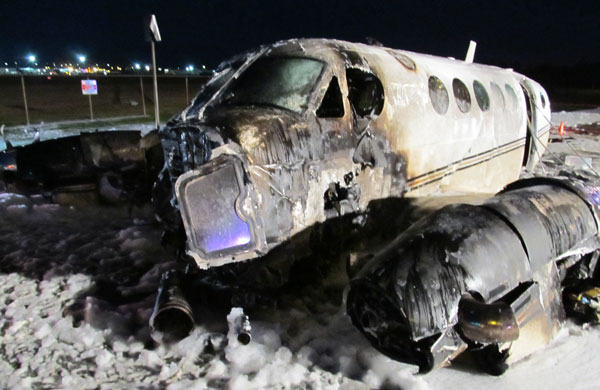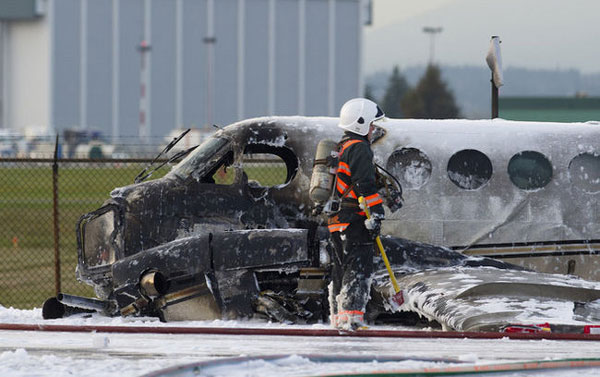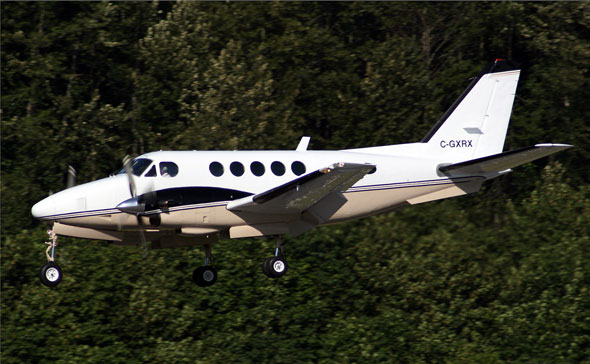Loss of Control and Collision with Ground
Northern Thunderbird Air Inc.
Beechcraft King Air 100, C-GXRX
Vancouver International Airport
Richmond, British Columbia
The occurrence
The Northern Thunderbird Air Incorporated Beechcraft King Air 100 (serial number B-36, registration C-GXRX) departed Vancouver International Airport for Kelowna, British Columbia, with 7 passengers and 2 pilots on board. About 15 minutes after take-off, the flight diverted back to Vancouver because of an oil leak. No emergency was declared. At 1611 Pacific Daylight Time, when the aircraft was about 300 feet above ground level and about 0.5 statute miles from the runway, it suddenly banked left and pitched nose-down. The aircraft collided with the ground and caught fire before coming to rest on a roadway just outside of the airport fence. Passersby helped to evacuate 6 passengers; fire and rescue personnel rescued the remaining passenger and the pilots. The aircraft was destroyed, and all of the passengers were seriously injured. Both pilots succumbed to their injuries in hospital. The aircraft’s emergency locator transmitter had been removed.
Media materials
News releases
Fatal October 2011 crash of King Air in Vancouver illustrates need for action to reduce risks of post-impact fires aboard small aircraft
Read the news release
Transportation Safety Board initiates investigation of crash of Northern Thunderbird Air Beechcraft King Air 100 in Richmond, British Columbia
Read the news release
Deployment notice
TSB Deploys Team to Investigate an Air Accident in British Columbia
Gatineau, Quebec, 27 October 2011 – The Transportation Safety Board of Canada (TSB) has deployed a team to the site of an air accident. A small plane, a Beechcraft 100 from the air carrier Northern Thunderbird Air (NT Air), has crashed on a road short of Vancouver International Airport. The TSB will be undertaking an investigation and will provide more details at a later time.
Investigation information
Download high-resolution photos from the TSB Flickr page.
Class of investigation
This is a class 3 investigation. These investigations analyze a small number of safety issues, and may result in recommendations. Class 3 investigations are generally completed within 450 days. For more information, see the Policy on Occurrence Classification.
TSB investigation process
There are 3 phases to a TSB investigation
- Field phase: a team of investigators examines the occurrence site and wreckage, interviews witnesses and collects pertinent information.
- Examination and analysis phase: the TSB reviews pertinent records, tests components of the wreckage in the lab, determines the sequence of events and identifies safety deficiencies. When safety deficiencies are suspected or confirmed, the TSB advises the appropriate authority without waiting until publication of the final report.
- Report phase: a confidential draft report is approved by the Board and sent to persons and corporations who are directly concerned by the report. They then have the opportunity to dispute or correct information they believe to be incorrect. The Board considers all representations before approving the final report, which is subsequently released to the public.
For more information, see our Investigation process page.
The TSB is an independent agency that investigates air, marine, pipeline, and rail transportation occurrences. Its sole aim is the advancement of transportation safety. It is not the function of the Board to assign fault or determine civil or criminal liability.


